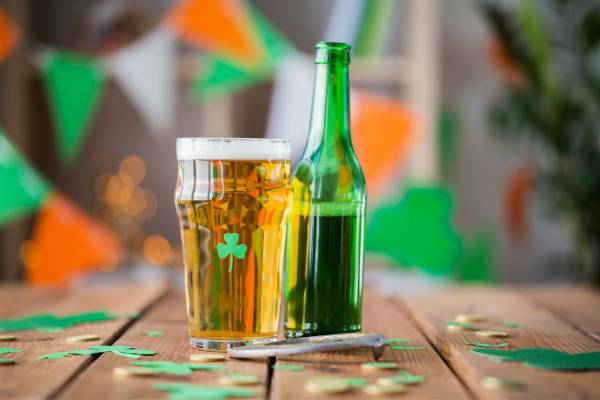As a craft beer lover and homebrewer, I’ve had the pleasure of tasting a wide variety of beer styles. Some of my favorite brews are those that go down smooth and easy on a warm day.
Two styles that fit this bill perfectly are Kölsch and Cream Ale. While they do share many similarities, they are also distinct in their own ways.
They are both fermented as ales but stored as lagers, and taste in a similar manner. However, they utilise different raw materials and yeast strains in their brewing process.
In this post, I’ll dive into the differences and similarities between these two refreshing brews, with Kölsch being a German-style ale and Cream Ale being an American-style hybrid. So let’s grab a pint, and get to it!
What is the difference between cream ale and Kölsch?
Cream ale and Kölsch are both light, refreshing beer styles with subtle differences in their flavor profiles and brewing techniques.
The main difference between the two lies in their ingredients, fermentation, and regional origins.
Cream ale is an American ale style, typically brewed with a mix of malted barley and corn or rice adjuncts.

It is fermented using ale yeast at a relatively warm temperature, followed by a period of cold conditioning (lagering). This process produces a light-bodied, crisp beer with a subtle malt sweetness and low hop bitterness.
Kölsch, on the other hand, originates from Cologne, Germany, and adheres to the German Beer Purity Law (Reinheitsgebot), which means it is brewed only with malted barley, hops, water, and yeast.
Kölsch is fermented with a unique Kölsch yeast strain at a warmer temperature than most lagers, and then cold-conditioned like a lager.
This hybrid brewing process results in a beer with a delicate balance of fruity esters, soft maltiness, and a slightly more pronounced hop character compared to cream ales.
In summary, cream ale is an American-style beer with a lighter body and subtle malt sweetness, while Kölsch is a German-style beer with a delicate balance of fruity esters, maltiness, and a slightly more pronounced hop character.
1. Origins: Germany vs America
The first major difference between Kölsch and Cream Ale is their origins. Kölsch hails from Cologne, Germany, and is a product of the city’s brewing tradition.
It’s a style that dates back to the early 17th century, and it’s a protected designation today – only beers brewed in Cologne can officially be called Kölsch.
On the other hand,Cream Ale is a distinctly American creation. It emerged in the mid-19th century, primarily as a response to the popularity of lager beers in the United States. Breweries wanted to create a lighter, more accessible ale that could compete with the easy-drinking lagers, and Cream Ale was born.
2. Brewing Process: Ale vs Hybrid
While both Kölsch and Cream Ale are brewed using top-fermenting ale yeasts, their brewing processes are different.
Kölsch is a true ale, fermented at slightly cooler temperatures than most ales (around 60°F) and then cold-conditioned (or “lagered”) for a few weeks. This unique process gives it a clean, crisp character while still retaining some fruity ale notes.

In contrast,Cream Ale is a hybrid beer style, meaning it combines elements of both ale and lager brewing. It’s usually brewed with a mix of ale and lager yeasts, or with ale yeast at cooler temperatures.

This process helps to produce a beer with a clean, lager-like character, while still being an ale at heart.
3. Ingredients: Similarities and Differences
Both Kölsch and Cream Ale are brewed with relatively simple ingredient lists, primarily using pale malted barley for their base. However, there are some differences in their grain bills.
Kölsch often includes a small percentage of wheat malt, which contributes to its light, crisp character and slightly hazy appearance.
On the other hand, Cream Ale frequently incorporates adjuncts like corn or rice, which help to lighten the body and create a more neutral flavor profile. This is a nod to the American lager tradition, as these adjuncts are often used in mass-produced lagers to achieve a similar effect.
4. Hops: Noble vs American
When it comes to hops, Kölsch and Cream Ale diverge once again. Kölsch typically utilizes German Noble hops, which lend a subtle, spicy, and floral character to the beer. These hops are used sparingly, as the focus is on balance and drinkability rather than intense hop flavor.
In contrast, Cream Ales can use either American or Noble hops, but the hop character is usually quite mild.
Some examples may lean more toward the American hop profile, with a touch of citrus or pine, while others might showcase the more delicate, floral notes of Noble hops. Regardless, the hop presence in Cream Ales should never be overpowering.
5. Appearance: Clear vs Hazy
Kölsch is generally a clear, pale golden beer with a moderate white head. Its clarity comes from the cold-conditioning process, which helps to drop out any suspended yeast and proteins.

However, the small amount of wheat malt used in some Kölsch recipes can sometimes result in a slight haze.
Cream Ale, on the other hand, is usually a brilliantly clear, straw-colored beer with a fluffy white head. Its clarity is a testament to the use of adjuncts like corn and rice, which help to create a more refined, clean appearance.
6. Flavor Profiles: Subtle Differences
Both Kölsch and Cream Ale are known for their clean, refreshing flavors and easy drinkability.
However, they do have some subtle differences in taste.
Kölsch tends to have a slightly fruity, vinous character, which comes from the unique fermentation process and the use of German Noble hops. It’s balanced by a delicate malt backbone and a subtle hop bitterness.
Cream Ale, meanwhile, is characterized by its light, crisp, and slightly sweet flavor profile. The use of adjuncts like corn and rice helps to create a smooth, easy-drinking beer with just a hint of hop flavor and a clean finish.
7. My Experience
I’ve had the pleasure of tasting several examples of both Kölsch and Cream Ale, both from commercial breweries and in homebrewed versions.

One of my favorite Kölsch experiences was at a beer festival, where a local German-style brewery had a beautifully crafted, perfectly balanced Kölsch. The subtle fruitiness and crisp finish made it an incredibly refreshing option on a hot summer day.
As for Cream Ale, I fondly remember a homebrewed version shared by a friend at a backyard barbecue. It was light, crisp, and had just a hint of citrusy hop flavor. It paired perfectly with grilled meats and good conversation, and it was a great reminder of the versatility and appeal of this underrated beer style.
Conclusion: 5 to 10 Facts About Kölsch and Cream Ale
In conclusion, while Kölsch and Cream Ale share some similarities in their drinkability and refreshing nature, they are distinct beer styles with different origins, ingredients, and brewing processes.
Here are some key facts to remember about these two delicious beers:
1. Kölsch is a German-style ale, while Cream Ale is an American-style hybrid.
2. Kölsch originates from Cologne, Germany, whereas Cream Ale was developed in the United States.
3. Kölsch is brewed with ale yeast and cold-conditioned, while Cream Ale often uses a mix of ale and lager yeasts or ale yeast at cooler temperatures.
4. Kölsch typically includes a small percentage of wheat malt, while Cream Ale often incorporates adjuncts like corn or rice.
5. Kölsch uses German Noble hops, while Cream Ale can use either American or Noble hops.
6. Kölsch is generally clear and pale golden, while Cream Ale is brilliantly clear and straw-colored.
7. Kölsch has a slightly fruity, vinous character, while Cream Ale is light, crisp, and slightly sweet.
8. Both styles are known for their clean, refreshing flavors and easy drinkability.
Now that you know the differences and similarities between Kölsch and Cream Ale, I encourage you to go out and try both styles for yourself. Cheers to exploring the diverse world of beer!
FAQs
What makes Kölsch beer different?
Kölsch beer is different due to its unique brewing process, regional origin, and distinct flavor profile. It is a light, crisp, and slightly fruity beer that originates from Cologne, Germany.
Kölsch is brewed using top-fermenting ale yeast but is then conditioned at colder temperatures like a lager, a process known as hybrid brewing.
This results in a clean, smooth taste with a delicate balance of malt and hops. Additionally, Kölsch is protected by an appellation, meaning that only beers brewed in Cologne and adhering to the Kölsch Konvention can be officially labeled as Kölsch.
What is the difference between a Kölsch and a pale ale?
The main difference between a Kölsch and a pale ale lies in their brewing process, ingredients, and flavor profiles. Kölsch is a German beer style that is brewed using top-fermenting ale yeast but is then cold-conditioned like a lager, resulting in a light, crisp, and slightly fruity beer.
It is typically brewed with German noble hops and Pilsner malt, giving it a delicate hop bitterness and a straw-yellow color.
On the other hand, pale ale is a broad category of English and American beers that are brewed with top-fermenting ale yeast and pale malt, resulting in a golden to amber color.
Pale ales often have a more pronounced hop character and a higher level of bitterness compared to Kölsch, with flavor profiles ranging from fruity and floral to piney and citrusy, depending on the hop varieties used.
What is Kölsch beer similar to?
Kölsch beer is similar to a German-style pale ale, specifically a combination of Pilsner and Helles lagers.
It is light, crisp, and refreshing with a delicate balance of maltiness and subtle fruitiness from the unique Kölsch yeast. It has a straw-yellow color, moderate hop bitterness, and a clean, dry finish.
What is so special about Kölsch beer?
Kölsch beer is special due to its unique brewing process, geographical origin, and distinctive flavor profile.
It is a light, crisp, and slightly fruity beer originating from Cologne, Germany. Kölsch is brewed using top-fermenting ale yeast but is then cold-conditioned like a lager, resulting in a hybrid style known as “obergärige Lagerbier.”
This brewing process imparts a delicate balance of maltiness and hop bitterness, with a clean, dry finish. Kölsch is also protected by an appellation, meaning that only beers brewed in Cologne and adhering to the Kölsch Konvention can be officially labeled as Kölsch.




